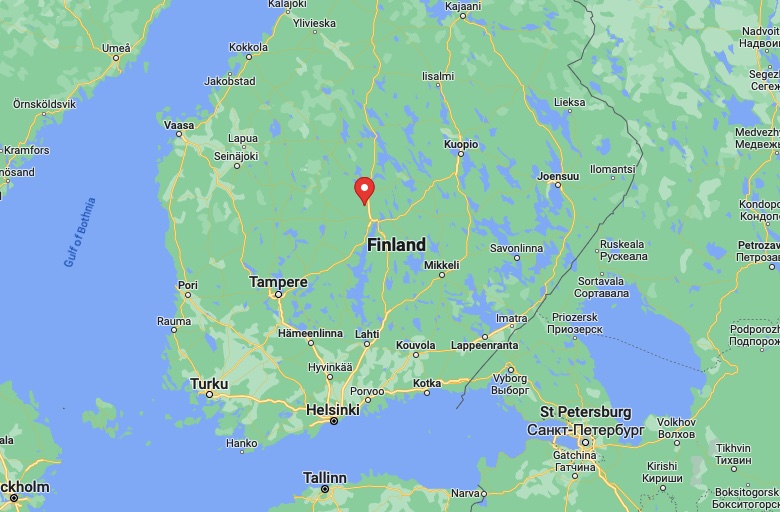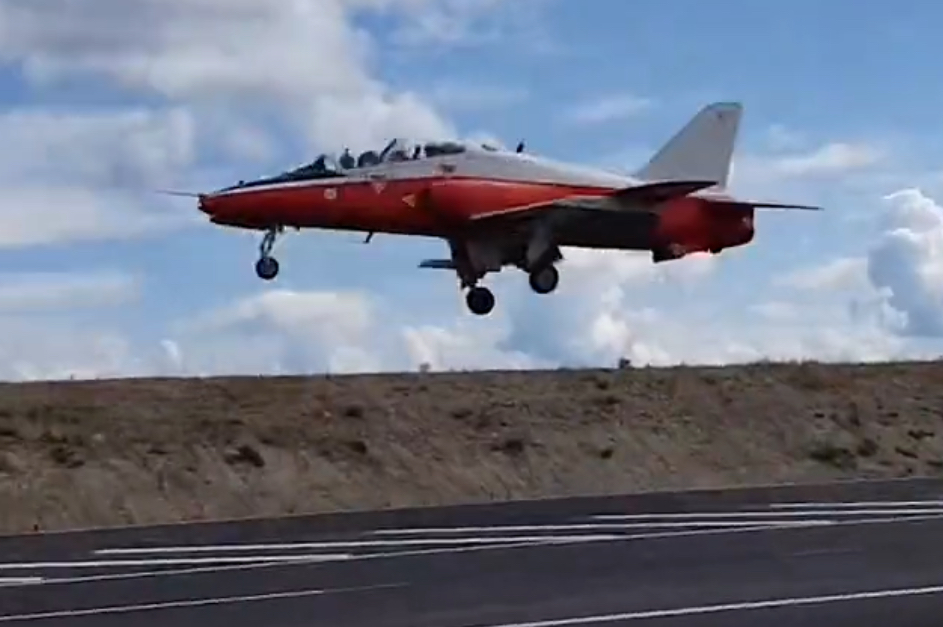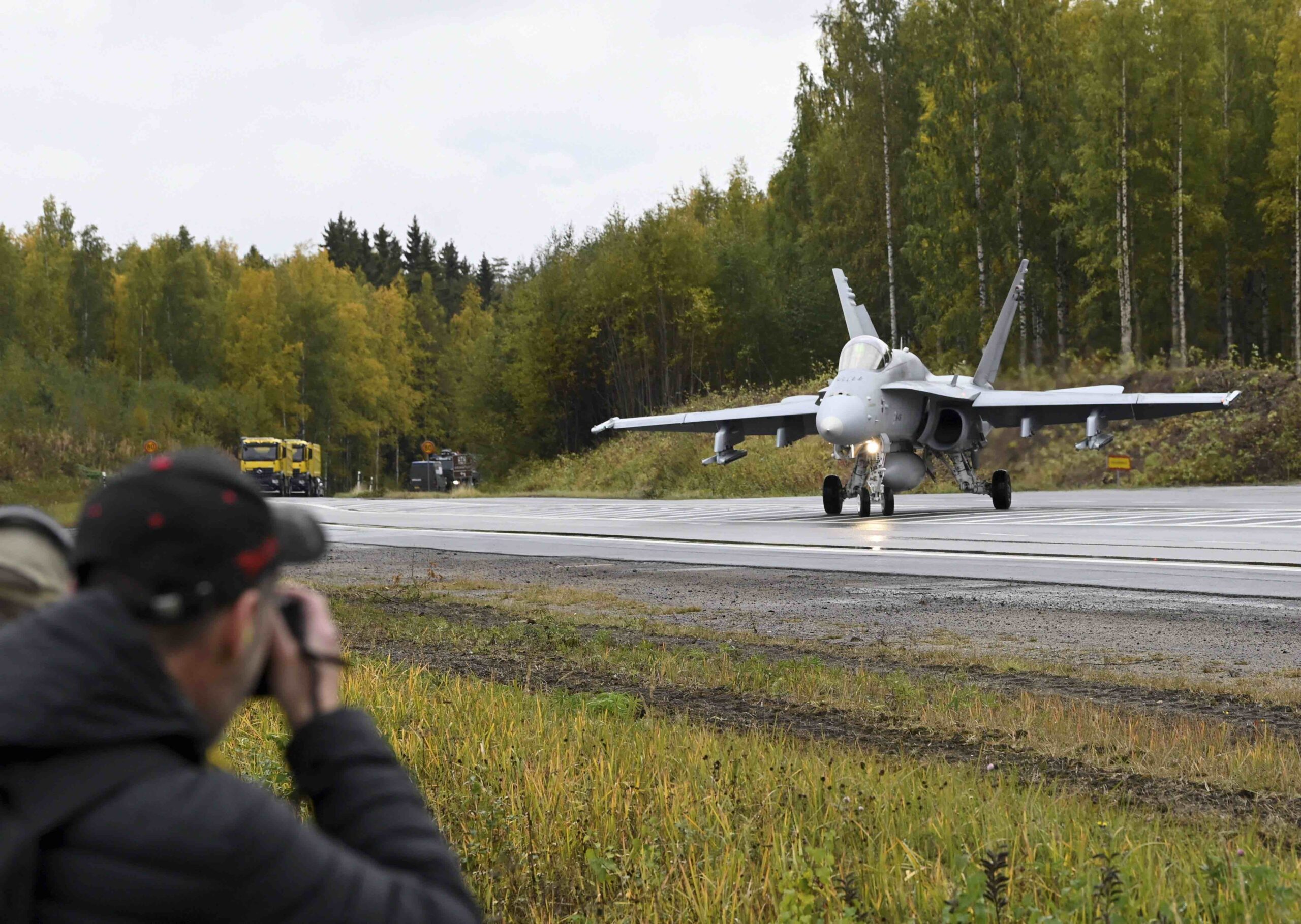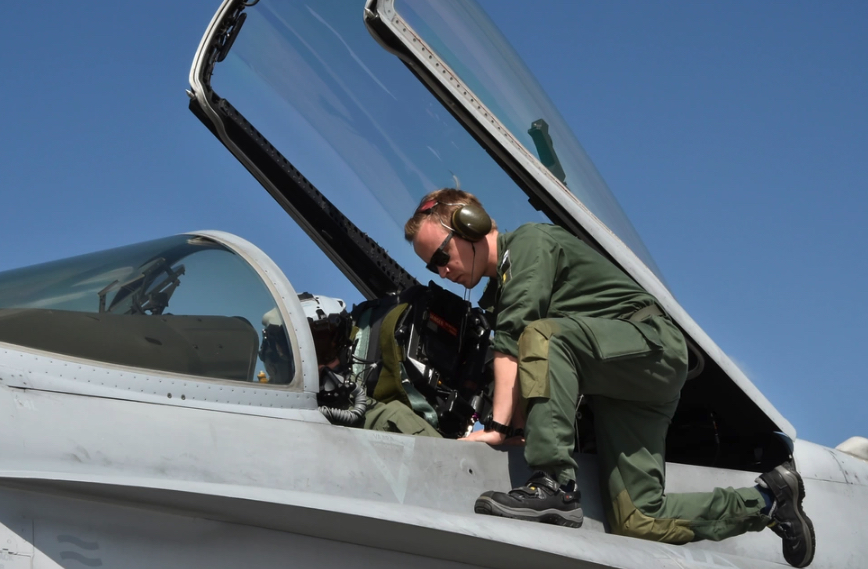While the Finnish Air Force, or Ilmavoimat, is well known for its use of highways for distributed operations, the sight of military aircraft operating from roadways is always something to behold. Case in point: the video below from the Ilmavoimat, which shows a pilot’s-eye view from an Airbus C295 twin-turboprop transport as it operates from a newly constructed highway specially designed with a runway at its center.
A new section of road on part of the country’s recently renovated Valtatie 4 highway (National Road Four) near Jyväskylä–Tikkakoski Air Base — located north of the city Jyväskylä — played host to Ilmavoimat aircraft from across the country as they performed highway operations. Kesäbaana 23, the exercise’s official title, ran from July 24-28.

The portion of the highway used for Kesäbaana 23, the exact length of which is unknown, currently remains closed to public transport due to ongoing paving work. At least part of said highway section features a unique design, whereby a dedicated reserve runway is sandwiched between four highway lanes.

The following aircraft were used as part of Kesäbaana 23: F/A-18C/D Hornets stationed at Kuopio and Rovaniemi AB, Learjet 35 and Pilatus PC-12 transports, Airbus C295 twin-turboprop cargo aircraft stationed at Tampere-Pirkkala AB, and Hawk Mk 66 training jets of the Air Operations Support Squadron stationed at Jyväskylä–Tikkakoski AB.
In the video above, we see the C295 circling the highway after taking flight. It also provides views of the aircraft landing. At present, the Finnish Air Force only has two C295M transports, as well as one which is adapted for SIGINT (signals intelligence)/ELINT (electronic intelligence).


Towards the end of the same video, F/A-18 Hornets can also be seen taking off. As of 2021, the Ilmavoimat had a fleet of 62 upgraded F/A-18C/D “legacy” Hornets, which the service began acquiring in the mid-1990s. Finland chose to replace its Hornet fleet with F-35A Lighting II Block 4 multirole fighters in 2021. The Ilmavoimat will receive 64 of those aircraft beginning in 2025.


The footage also shows a Hawk Mk 66 taking off from the strip. Although Hawks have been in service with the Ilmavoimat since 1980, it is only since 2011 that Hawk 66s have been used by Finland — following a deal to procure 18 airframes from Switzerland in 2007. As of 2020, the Ilmavoimat had a fleet of 32 Hawks, including 16 Mk 66s.

Below you can see video of a Hawk Mk 66 performing a touch-and-go landing during Kesäbaana 23 — which involves landing on a runway and taking off again without coming to a full stop.

According to local Finnish media, in order to facilitate the exercise much of the training area remained closed to the public, aside from a small spectators’ area to the south. It’s unclear exactly how much preparation work was needed prior to the start of Kesäbaana 23. As The War Zone has noted in the past, highway strips sometimes require fairly significant changes to be made, such as removing crash barriers, power lines, signage, and lighting, for aircraft takeoff and landings. However, the footage seen above shows that significant lighting and signage remained around portions of the strip. This is likely due at least in part to its unique design where the runway was built into the center of the roadway instead of sharing the car lanes as an operating area.
Given the proximity of National Road Four to Jyväskylä–Tikkakoski AB, it makes good sense that a reserve runway would be constructed close by. Jyväskylä–Tikkakoski is home to the Finnish Air Force headquarters, alongside the Finnish Air Force Academy. The strip itself is part of a new 16-kilometer (roughly 10-mile) stretch of motorway between the city of Jyväskylä and the municipality of Laukaa. The main construction effort, which is set to be completed this year, has seen the creation of a two-plus-two-lane motorway with a central barrier. National Road Four connects the capital Helsinki to the more northern parts of the country.

Speaking to Finland’s MTV News, aviation photographer Tim Ollikainen, who was present for the exercises on July 26, noted, “This is a significantly different Baana [the Ilmavoimat’s annual road-based training exercise] than others found in Finland. The runway and the driving lane are separated from each other, while in other places the runway is over the car lanes. Looks impressive and will certainly respond well to F-35 operations in the future.”
The use of various motorways, specifically for practicing distributed operations, by the Ilmavoimat very much remains routine. Just last year, Finland closed a two-kilometer (1.24-mile) stretch of National Road Four for the first time in decades, specifically for road-based exercises. Those similarly lasted for five days, involving some 200 personnel and F/A-18 jets, Hawk Mk 51 trainers, and other military aircraft.

Annual road-based operations of this sort have formed a core training component for Finnish pilots for some time. Over the past 50 years, starting during the Cold War, all Ilmavoimat pilots — flying all aircraft types — have been required to be qualified on highway strip operations as part of their training.
The need for distributed operations training beyond conventional airbases owes much to Finland’s proximity to Russia — with Finland sharing an 845-mile border with Russia to the east. In any potential conflict between the two countries, as we’ve noted previously, it would be important for the Ilmavoimat to get as many aircraft in the air as rapidly as possible to shield them from standoff attacks on its established airbases, which would certainly be prime targets.
Training with Hornets in particular, which have made a noticeable appearance at various road-based exercises in recent years, makes sense given the important standoff strike and air defense roles those aircraft would play in such a conflict. Indeed, Finland has often scrambled its Hornets to intercept Russian aircraft near its land and sea borders and has accused them of violating its sovereign airspace on multiple occasions in recent years.
Finland’s Hornets are capable of launching AGM-154 Joint Stand-Off Weapon (JSOW) glide bombs and AGM-158A Joint Air-to-Surface Standoff Missile (JASSM) cruise missiles, both of which have stealthy features and would be essential for penetrating Russia’s dense integrated air defenses in order to engage targets, as well as neutralizing those defenses themselves.

All of this has taken on even greater significance since Russia began its all-out war against Ukraine in February 2022. As Colonel Vesa Mantyla, head of the Finnish Air Force Academy, said of last year’s road-based operations to Reuters, “The threat from Russia or the actions from Russia with the cruise missiles and ballistic missiles [in Ukraine] proves that the concept of dispersed operations is right.”
Dispersed operations have also seen a resurgence in other European countries as of late in light of the war in Ukraine, notably the U.K.’s Royal Air Force, which plans to demonstrate highway and other dispersed operations with F-35Bs and Typhoons. The U.K. Typhoons will operate from Finnish highways within the next few months, while F-35Bs will do the same likely from locations within the U.K.
Moreover, distributed operations involving roadways have even become a part of some U.S. Air Force training exercises stateside in recent years. The service has conducted highway operations with aircraft, such as A-10 Warthogs and C-130 Hercules, as well as uncrewed platforms such as MQ-9 Reaper drones. These initiatives fit broadly within the Air Force’s Agile Combat Employment (ACE) concepts of operation. ACE is centered on irregular and unpredictable deployments at speed, something which the service has been testing specifically in the Indo-Pacific context for some time.
For the Ilmavoimat more specifically, Finland, along with Denmark, Norway and Sweden, formed a unified Nordic air defense alliance in a bid to better cope with threats emanating from Russia back in March. As Major General Jan Dam, commander of the Danish Air Force, told Reuters, the impetus behind that initiative — to develop a Nordic concept for joint air operations based on already-known NATO methodology — was triggered by Moscow’s invasion of Ukraine. Those countries have upwards of 300 fighter jets between them as well as training, transport and surveillance fixed-wing aircraft and helicopters.
Meanwhile, in April, Finland officially joined the NATO alliance after applying for membership in May of 2022 owing to concerns about the ongoing war. The Finnish Air Force has played a key role in NATO exercises since becoming an official member. Exercise Air Defender 2023 (AD23), the largest air combat exercise in NATO’s history, saw Ilmavoimat Hornets participate in a number of interoperability demonstrations alongside aircraft from Germany, the U.S., the U.K., France, and Japan.

With that said, Kesäbaana 23 underscores Finland’s commitment to maximizing the utility of the Ilmavoimat’s various aircraft from a variety of operating locations.
Contact the author: oliver@thewarzone.com
